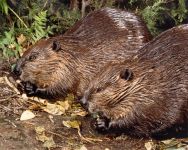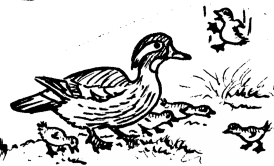


|

|
|
 
|
by Hope Sawyer Buyukmihci
Published in the Spring 2013 issue of The Beaver Defenders
Over our cabin roof at Unexpected Wildlife Refuge in New Jersey there sits a big birdhouse on a post. This year, after Charlie the Grey Squirrel had raised three youngsters in it, we began to see a wood duck pair fly to the box each evening, always at 8 o'clock. The female entered, while the male flew past to alight on a high oak branch not far away. He sat there and preened, then flew down to the cove and floated on the water until darkness fell.
The wood duck, Aix sponsa, called America's most beautiful duck, is only 20 inches long, compared to the common mallard of 28 inches. The male's flowing crest is iridescent blue-green with white stripes, and he has patches of bright colors and white patterns in gay crazy-quilt effect. His mate is crested also, but her colors are subdued brown and buff, with a white ellipse around her eye. The eyes of both are red.
Normally the wood duck houses a hollow tree for nesting, close beside a stream or pond. As early as February, in New Jersey, the pair may be inspecting tree hollows, sometimes more than thirty feet from the ground. If they cannot find a suitable cavity, the female may nest on a limb or even on the ground. They readily take to a man-made house with a four-inch hole.
For several weeks we had seen the two fly to the birdhouse, and knew she was laying eggs. Then she came alone, indicating that incubation had begun. Her mate would have joined other males for the early-summer molt, losing his bright feathers and his power of flight until late summer. By October he would be in brilliant plumage again, and remain so all winter.
The female would sit 28-30 days on eight to fifteen brownish eggs. Her nest was lined with fluff pulled from her breast – a special down grown each year as part of her nuptial plumage. Coming from feeding each day, she would supply necessary moisture with water gathered and held among her feathers and she would turn the eggs regularly for even incubation.
Our observations had been intermittent, and we were not sure just when the eggs would hatch. At 9AM on June 14, we heard a strange noise outside the livingroom window. On the ground stood the mother wood duck, looking upward and calling, in a voice like a yellow-billed cuckoo's. Several fuzzy smoke and yellow ducklings were already with her.

Just then a thump came on the roof. Next, a duckling sailed down past the window and landed among the violets and wild roses. Soon others fell, some of them bouncing off the roof on their way. Landing, each scrambled up and ran to his mother. When ten were assembled, she led them across the driveway and into the side yard of unmowed grass toward the wooded stream.
Like some other tree-ducks, the wood duck calls her young from the nest when they are only about a day old. Equipped with claws on their webbed feet and a hook on their beaks, they can climb from a very deep hollow. At their mother's call they gather at the entrance and either jump or are jostled out, to tumble as much as fifty feet. Their landing is usually on forest duff or directly into water.
Wood ducklings spend several weeks paddling around the swamp eating mosquito wigglers and other insects, led by their mother. Alert for danger, she has several ways of protecting her young. In the water she sends them racing to hide among aquatic plants while she faces the enemy and tries to lead him away. If surprised on shore the mother may feign a broken wing and flop about crying piteously, keeping just out of reach, while her young squat silently or hurry away. If the intruder comes too close she may rush at him with flapping wings and hysteric cries.
Sometimes a young duck will fall prey to a fox or weasel, and in the water a mink may catch one or a snapping turtle may pull one down. By fall the original brood may be reduced to half its number or even less.
As the ducklings grow, they travel up and down a particular stretch of stream or even venture across big ponds, hurrying through the open water to the safety of plants along the shore. During blueberry season, ducklings leap from the water, flailing their wings, to grab ripe berries from overhanging branches. Later they feed on ilex and other wild fruits in the same manner. They eat cones and galls, sedge seeds and grass seeds, pondweeds and nuts. And always insects when they can get them.
At one time, the wood duck was suggested as our national bird because of his beauty, his peaceful habits and his nesting in very state of the Union (except Alaska and Hawaii). But he was not elected. America's most beautiful duck is still classified as a game bird and used as a target.